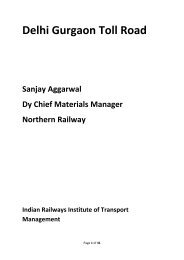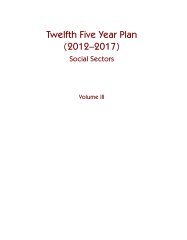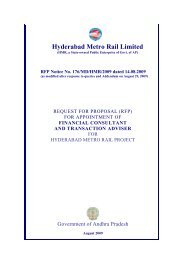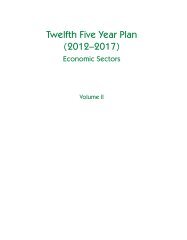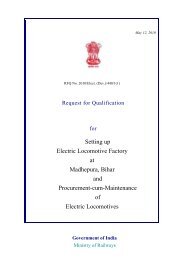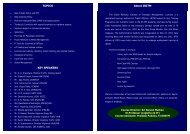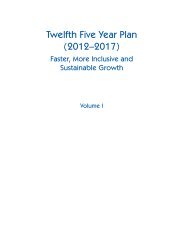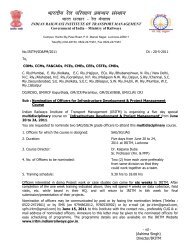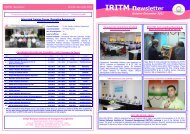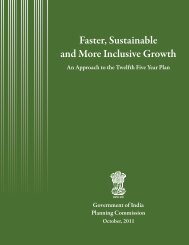Vision 2020 - Transportation Research Group of India
Vision 2020 - Transportation Research Group of India
Vision 2020 - Transportation Research Group of India
Create successful ePaper yourself
Turn your PDF publications into a flip-book with our unique Google optimized e-Paper software.
Government <strong>of</strong> <strong>India</strong><br />
Ministry <strong>of</strong> Railways<br />
(Railway Board)<br />
Besides these functional inadequacies, most <strong>of</strong> the stations have not been built with any architectural or<br />
aesthetic consideration and as a result act as poor introduction to the cities they serve.<br />
These stations must be easy to access and use, pleasant to spend time in and must be fully integrated with the<br />
surrounding city. 50 stations have already been targeted for development as world-class stations. New<br />
directional terminals need to be built in major metropolitan cities. This calls for massive resources and<br />
organizational capabilities. Leveraging a part <strong>of</strong> the real-estate occupied by the stations, including the use <strong>of</strong> the<br />
airspace, and viability gap funding by government could make development <strong>of</strong> such stations an attractive<br />
proposition for PPP. However, developing, awarding and executing projects <strong>of</strong> such complexity through PPP are<br />
a serious challenge.<br />
d) Slow-moving Passenger Services<br />
Passenger services stopping at all stations are run with poor-quality coaches. These also pose a serious<br />
challenge to management <strong>of</strong> train operations in a freight-passenger mixed environment. Introduction <strong>of</strong> modern,<br />
comfortable Electrical Multiple Units/ Modified Electrical Multiple Units/Diesel Multiple Units<br />
(EMU/MEMU/DMUs) capable <strong>of</strong> quick acceleration/deceleration to replace slow-moving passenger trains would<br />
not only enhance the quality <strong>of</strong> service, but also help improve operations.<br />
(e) Raising <strong>of</strong> Speed<br />
Improvement <strong>of</strong> speed to 160-200 kmph on segregated passenger corridors would be necessary to meet the<br />
requirement <strong>of</strong> fast intercity travel between major cities. In the long run, however, genuine high speed trains with<br />
travel speeds exceeding 300 kmph would be needed to keep pace with developments in other parts <strong>of</strong> the world.<br />
(f)<br />
High-speed trains<br />
Construction and operation <strong>of</strong> high speed lines is, however, very expensive and would require capital infusion<br />
and passenger patronage <strong>of</strong> a very high order. Massive capital investment would necessitate running <strong>of</strong> trains at<br />
frequent intervals <strong>of</strong> 5-10 minutes with sufficient load factors. Farebox revenues may not be sufficient to cover<br />
cost <strong>of</strong> infrastructure and operation for a long time. This would, therefore, call for innovative approaches; a<br />
mix <strong>of</strong> viability gap funding from government - both at central and state levels- and leveraging <strong>of</strong> realestate<br />
would be necessary to attract successful PPP interest in these projects.<br />
(g)<br />
Suburban Transport<br />
In the suburban segment, the main challenges are the creation <strong>of</strong> adequate capacity, segregation <strong>of</strong> commuter<br />
lines from long-distance lines and expansion <strong>of</strong> services to ensure comfort <strong>of</strong> commuters. Partnership with state<br />
authorities will be necessary for development <strong>of</strong> suburban rail systems. Railways may also aim at integrating the<br />
metro-rail and sub-urban rail-systems under a single management in partnership with the respective state/city<br />
authorities.<br />
3.4 Challenges for Parcel Business<br />
In parcel business, the main challenges are enhancement <strong>of</strong> carrying capacity (rolling stock and dedicated<br />
terminal infrastructure) and re-positioning the business as a separate service rather than a piggy-back service <strong>of</strong><br />
14




